The Flea's Tribute to the Classic...
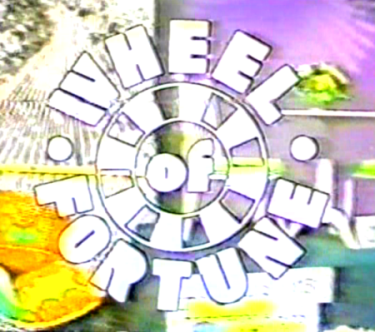
Broadcast History: NBC daytime January 6, 1975-December 25, 1981
Host: Chuck Woolery
Announcers: Charlie O'Donnell (1975-80) and Jack Clark (1980-81)
Packager: Merv Griffin Productions
Wheel of Fortune was first conceived in 1973 as a pilot called "Shopper's Bazzar". The focus of the game was not on puzzles, but on contestants shopping for "glamorous" or "extravagant" prizes. The pilot was a bust, but NBC commissioned a second pilot a year later and it was picked up. Merv Griffin, who created the show, managed to get the series onto NBC's daytime schedule by agreeing to discontinue production of Jeopardy! 9 months before its contract had ended.
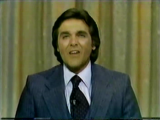
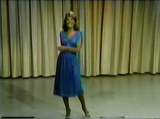 Merv Griffin selected Chuck Woolery to host his new show, and teamed him with hostess/letter-turner Susan Stafford (Vanna White would not take over until December 1982). The game was then much simpler and the set much plainer. No video walls or exotic location settings, just prizes, the wheel and the puzzle board. The top dollar spaces ranged from $500 in round one to $2000 in the last round of the game. Vowels, as they do today, cost $250. Very early in the run, there was actually a "Buy a Vowel" space on the wheel, but the producers realized this concept to be redundant and the space quickly disappeared.
Merv Griffin selected Chuck Woolery to host his new show, and teamed him with hostess/letter-turner Susan Stafford (Vanna White would not take over until December 1982). The game was then much simpler and the set much plainer. No video walls or exotic location settings, just prizes, the wheel and the puzzle board. The top dollar spaces ranged from $500 in round one to $2000 in the last round of the game. Vowels, as they do today, cost $250. Very early in the run, there was actually a "Buy a Vowel" space on the wheel, but the producers realized this concept to be redundant and the space quickly disappeared.
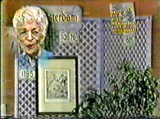 Unlike today's version of Wheel of Fortune, players who correctly solved puzzles didn't keep the cash they had accumulated during the round, but used it to select prizes instead. There were four different prize themes on stage (living room, game room, fashion botique, etc.), and when a contestant solved a puzzle correctly he was able to select from one of these theme areas onstage. The only time he could select a prize from elsewhere onstage was if he had accumulated enough cash to buy the car.
Unlike today's version of Wheel of Fortune, players who correctly solved puzzles didn't keep the cash they had accumulated during the round, but used it to select prizes instead. There were four different prize themes on stage (living room, game room, fashion botique, etc.), and when a contestant solved a puzzle correctly he was able to select from one of these theme areas onstage. The only time he could select a prize from elsewhere onstage was if he had accumulated enough cash to buy the car.
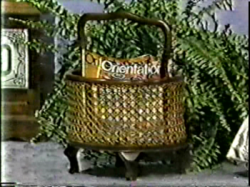
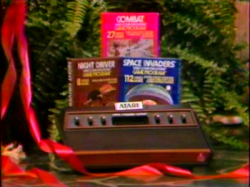 Generally, the prizes ranged from a car worth around $6,000 to trips worth around $2,000-$4,000 to such inexpensive (and undesireable) fare sometimes valued under $100 like towel sets, magazine racks (like the one pictured here), and ceramic dalmations. In between, prizes such as pool tables, stereos, and TV sets (usually valued between $200-$1,000) were popular choices among winning contestants. After they were through shopping, contestants generally took whatever change they had left and put it on a gift certificate, though they had the choice of putting it "on account" to use in later rounds. The latter option was seldom used, since it was such a risk and since most players generally had only miniscule amounts left after their shopping sprees.
Generally, the prizes ranged from a car worth around $6,000 to trips worth around $2,000-$4,000 to such inexpensive (and undesireable) fare sometimes valued under $100 like towel sets, magazine racks (like the one pictured here), and ceramic dalmations. In between, prizes such as pool tables, stereos, and TV sets (usually valued between $200-$1,000) were popular choices among winning contestants. After they were through shopping, contestants generally took whatever change they had left and put it on a gift certificate, though they had the choice of putting it "on account" to use in later rounds. The latter option was seldom used, since it was such a risk and since most players generally had only miniscule amounts left after their shopping sprees.
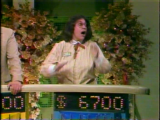
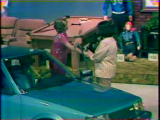 The most expensive (and most coveted) prize offered was a car, usually a lower-end model such as a Pontiac station wagon or a Mazda hatchback. The excited contestant pictured above has just won $6,700--enough to buy the car with. It was a nice present for her family at an appropriate time, as the episode aired on Christmas Eve 1980.
The most expensive (and most coveted) prize offered was a car, usually a lower-end model such as a Pontiac station wagon or a Mazda hatchback. The excited contestant pictured above has just won $6,700--enough to buy the car with. It was a nice present for her family at an appropriate time, as the episode aired on Christmas Eve 1980.

 Yet another feature unlike today's Wheel is the lack of any bonus round. After as many rounds as possible were crammed into the show (usually 3 full rounds with a 4th speed-up round), the player with the highest total was declared the champ and allowed to return for up to 3 days. Any player who won on 3 consecutive shows was automatically retired.
Yet another feature unlike today's Wheel is the lack of any bonus round. After as many rounds as possible were crammed into the show (usually 3 full rounds with a 4th speed-up round), the player with the highest total was declared the champ and allowed to return for up to 3 days. Any player who won on 3 consecutive shows was automatically retired.
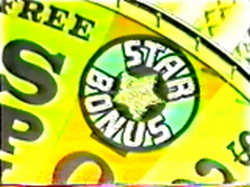
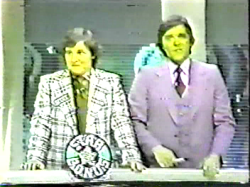 For a brief time in 1978, more than 3 years prior to the introduction of the bonus round we know today, Wheel of Fortune introduced the "Star Bonus" space on the wheel. Any player who landed on this space would have the chance at the end of the game to play a bonus puzzle.
For a brief time in 1978, more than 3 years prior to the introduction of the bonus round we know today, Wheel of Fortune introduced the "Star Bonus" space on the wheel. Any player who landed on this space would have the chance at the end of the game to play a bonus puzzle.
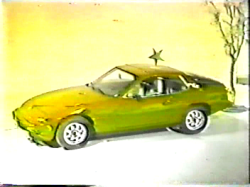
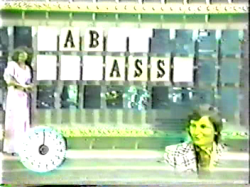 The player who won the opportunity to play the bonus puzzle could choose from among four different puzzles of varying difficulty. The more difficult the puzzle, the more expensive the prize. The "easy" puzzle would offer a cheap prize, like a $675 trip to Las Vegas; more difficult puzzles would offer gift certificates or jewelry; the most difficult puzzle offered a prize worth over $10,000--such as a $13,000 Porche. This space was not used for very long, mainly because whenever it was landed on it forced the rest of the show to be choppily edited so they could fit the Star Bonus puzzle in at the end of the show.
The player who won the opportunity to play the bonus puzzle could choose from among four different puzzles of varying difficulty. The more difficult the puzzle, the more expensive the prize. The "easy" puzzle would offer a cheap prize, like a $675 trip to Las Vegas; more difficult puzzles would offer gift certificates or jewelry; the most difficult puzzle offered a prize worth over $10,000--such as a $13,000 Porche. This space was not used for very long, mainly because whenever it was landed on it forced the rest of the show to be choppily edited so they could fit the Star Bonus puzzle in at the end of the show.
 In 1980, third place network NBC decided they needed to spice up their daytime schedule and picked a new, 90-minute talk show featuring a young comedian named David Letterman. Three game shows were to be the casualties of NBC's new daytime direction, and several mock schedules were proposed--one of which gave Wheel of Fortune the axe. In the end, Wheel of Fortune (along with Card Sharks and Password Plus) survived, and the shows that ultimately got the chop were Chain Reaction, High Rollers, and the long-running Hollywood Squares. Thus, June 20, 1980, rather than being a farewell episode, was just another Friday for Chuck, Susan, and Wheel of Fortune.
In 1980, third place network NBC decided they needed to spice up their daytime schedule and picked a new, 90-minute talk show featuring a young comedian named David Letterman. Three game shows were to be the casualties of NBC's new daytime direction, and several mock schedules were proposed--one of which gave Wheel of Fortune the axe. In the end, Wheel of Fortune (along with Card Sharks and Password Plus) survived, and the shows that ultimately got the chop were Chain Reaction, High Rollers, and the long-running Hollywood Squares. Thus, June 20, 1980, rather than being a farewell episode, was just another Friday for Chuck, Susan, and Wheel of Fortune.
 Also in 1980, Wheel of Fortune used the November sweeps period to do a number of theme weeks. One of them featured members of the United States Armed Forces as contestants, and another featured hosts of NBC game shows playing for a member of the studio audience. The November 7, 1980 episode, in which game show host Tom Kennedy plays for an audience member, survives and is circulated among game show enthusiasts on the Internet. The above photo, with Tom Kennedy flanked by Chuck and Susan, is from that episode.
Also in 1980, Wheel of Fortune used the November sweeps period to do a number of theme weeks. One of them featured members of the United States Armed Forces as contestants, and another featured hosts of NBC game shows playing for a member of the studio audience. The November 7, 1980 episode, in which game show host Tom Kennedy plays for an audience member, survives and is circulated among game show enthusiasts on the Internet. The above photo, with Tom Kennedy flanked by Chuck and Susan, is from that episode.
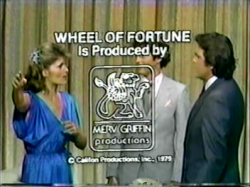
In 1981, after nearly 7 years and more than 1,600 episodes, Chuck Woolery left Wheel of Fortune in a salary dispute with Merv Griffin. The Christmas 1981 episode was his last, and Pat Sajak took over the following Monday. Griffin reportedly never forgave Woolery, and it is rumored that he had all of Woolery's Wheel of Fortune episodes destroyed (though this is an unsubstantiated claim). In any event, very few episodes are known to exist today, with many of those that do survive having been preserved by primitive BetaMax VCRs. An additional handful of episodes reside in the New York Museum of TV & Radio, where they can be viewed for a fee.
Homepage
Wheel of Fortune is owned by Merv Griffin Productions. No challenge to ownership is implied by this website.
This page hosted by
 Get your own Free Homepage
Get your own Free Homepage




 Unlike today's version of Wheel of Fortune, players who correctly solved puzzles didn't keep the cash they had accumulated during the round, but used it to select prizes instead. There were four different prize themes on stage (living room, game room, fashion botique, etc.), and when a contestant solved a puzzle correctly he was able to select from one of these theme areas onstage. The only time he could select a prize from elsewhere onstage was if he had accumulated enough cash to buy the car.
Unlike today's version of Wheel of Fortune, players who correctly solved puzzles didn't keep the cash they had accumulated during the round, but used it to select prizes instead. There were four different prize themes on stage (living room, game room, fashion botique, etc.), and when a contestant solved a puzzle correctly he was able to select from one of these theme areas onstage. The only time he could select a prize from elsewhere onstage was if he had accumulated enough cash to buy the car.

 Generally, the prizes ranged from a car worth around $6,000 to trips worth around $2,000-$4,000 to such inexpensive (and undesireable) fare sometimes valued under $100 like towel sets, magazine racks (like the one pictured here), and ceramic dalmations. In between, prizes such as pool tables, stereos, and TV sets (usually valued between $200-$1,000) were popular choices among winning contestants. After they were through shopping, contestants generally took whatever change they had left and put it on a gift certificate, though they had the choice of putting it "on account" to use in later rounds. The latter option was seldom used, since it was such a risk and since most players generally had only miniscule amounts left after their shopping sprees.
Generally, the prizes ranged from a car worth around $6,000 to trips worth around $2,000-$4,000 to such inexpensive (and undesireable) fare sometimes valued under $100 like towel sets, magazine racks (like the one pictured here), and ceramic dalmations. In between, prizes such as pool tables, stereos, and TV sets (usually valued between $200-$1,000) were popular choices among winning contestants. After they were through shopping, contestants generally took whatever change they had left and put it on a gift certificate, though they had the choice of putting it "on account" to use in later rounds. The latter option was seldom used, since it was such a risk and since most players generally had only miniscule amounts left after their shopping sprees.

 The most expensive (and most coveted) prize offered was a car, usually a lower-end model such as a Pontiac station wagon or a Mazda hatchback. The excited contestant pictured above has just won $6,700--enough to buy the car with. It was a nice present for her family at an appropriate time, as the episode aired on Christmas Eve 1980.
The most expensive (and most coveted) prize offered was a car, usually a lower-end model such as a Pontiac station wagon or a Mazda hatchback. The excited contestant pictured above has just won $6,700--enough to buy the car with. It was a nice present for her family at an appropriate time, as the episode aired on Christmas Eve 1980.

 Yet another feature unlike today's Wheel is the lack of any bonus round. After as many rounds as possible were crammed into the show (usually 3 full rounds with a 4th speed-up round), the player with the highest total was declared the champ and allowed to return for up to 3 days. Any player who won on 3 consecutive shows was automatically retired.
Yet another feature unlike today's Wheel is the lack of any bonus round. After as many rounds as possible were crammed into the show (usually 3 full rounds with a 4th speed-up round), the player with the highest total was declared the champ and allowed to return for up to 3 days. Any player who won on 3 consecutive shows was automatically retired.

 For a brief time in 1978, more than 3 years prior to the introduction of the bonus round we know today, Wheel of Fortune introduced the "Star Bonus" space on the wheel. Any player who landed on this space would have the chance at the end of the game to play a bonus puzzle.
For a brief time in 1978, more than 3 years prior to the introduction of the bonus round we know today, Wheel of Fortune introduced the "Star Bonus" space on the wheel. Any player who landed on this space would have the chance at the end of the game to play a bonus puzzle.

 The player who won the opportunity to play the bonus puzzle could choose from among four different puzzles of varying difficulty. The more difficult the puzzle, the more expensive the prize. The "easy" puzzle would offer a cheap prize, like a $675 trip to Las Vegas; more difficult puzzles would offer gift certificates or jewelry; the most difficult puzzle offered a prize worth over $10,000--such as a $13,000 Porche. This space was not used for very long, mainly because whenever it was landed on it forced the rest of the show to be choppily edited so they could fit the Star Bonus puzzle in at the end of the show.
The player who won the opportunity to play the bonus puzzle could choose from among four different puzzles of varying difficulty. The more difficult the puzzle, the more expensive the prize. The "easy" puzzle would offer a cheap prize, like a $675 trip to Las Vegas; more difficult puzzles would offer gift certificates or jewelry; the most difficult puzzle offered a prize worth over $10,000--such as a $13,000 Porche. This space was not used for very long, mainly because whenever it was landed on it forced the rest of the show to be choppily edited so they could fit the Star Bonus puzzle in at the end of the show.
 In 1980, third place network NBC decided they needed to spice up their daytime schedule and picked a new, 90-minute talk show featuring a young comedian named David Letterman. Three game shows were to be the casualties of NBC's new daytime direction, and several mock schedules were proposed--one of which gave Wheel of Fortune the axe. In the end, Wheel of Fortune (along with Card Sharks and Password Plus) survived, and the shows that ultimately got the chop were Chain Reaction, High Rollers, and the long-running Hollywood Squares. Thus, June 20, 1980, rather than being a farewell episode, was just another Friday for Chuck, Susan, and Wheel of Fortune.
In 1980, third place network NBC decided they needed to spice up their daytime schedule and picked a new, 90-minute talk show featuring a young comedian named David Letterman. Three game shows were to be the casualties of NBC's new daytime direction, and several mock schedules were proposed--one of which gave Wheel of Fortune the axe. In the end, Wheel of Fortune (along with Card Sharks and Password Plus) survived, and the shows that ultimately got the chop were Chain Reaction, High Rollers, and the long-running Hollywood Squares. Thus, June 20, 1980, rather than being a farewell episode, was just another Friday for Chuck, Susan, and Wheel of Fortune.
 Also in 1980, Wheel of Fortune used the November sweeps period to do a number of theme weeks. One of them featured members of the United States Armed Forces as contestants, and another featured hosts of NBC game shows playing for a member of the studio audience. The November 7, 1980 episode, in which game show host Tom Kennedy plays for an audience member, survives and is circulated among game show enthusiasts on the Internet. The above photo, with Tom Kennedy flanked by Chuck and Susan, is from that episode.
Also in 1980, Wheel of Fortune used the November sweeps period to do a number of theme weeks. One of them featured members of the United States Armed Forces as contestants, and another featured hosts of NBC game shows playing for a member of the studio audience. The November 7, 1980 episode, in which game show host Tom Kennedy plays for an audience member, survives and is circulated among game show enthusiasts on the Internet. The above photo, with Tom Kennedy flanked by Chuck and Susan, is from that episode.
